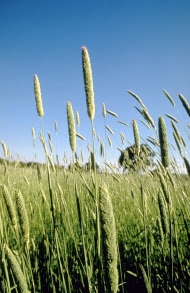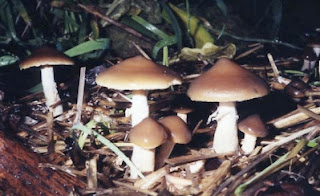Trippin' in your own backyard: Psychedelic drugs in plants and fungi found naturally in the USA
First off, apologies in advance for the exclusive focus on the United States in this post. I realize that many of you aren't from the US of A. Heck, I'm not. But I found a cool article on PubMed and I thought you people might find it interesting. So I've summarized it for y'all. Don't know about you, but I have a tendency to associate drug-containing plants and fungi with exotic locales. Anticancer drugs from the Amazon Rainforest. Opium from Afghanistan. Cocaine from Columbia. That sort of thing. So when I came across an article on drugs, psychedelic drugs no less, found in plants and fungi that have established themselves in American soil, I was intrigued. Please note that I will be discussing species that are growing wild, not those being cultivated in greenhouses and suburban basements.

The short-acting hallucinogen DMT, most often associated with the Amazonian brew ayahuasca, is also present in appreciable quantities in several common species of grass belonging to the genus Phalaris, including P. aquatica (bulbous canarygrass, Harding Grass), P. arundinacea (reed canary grass), and P. brachystachys (shortspike canarygrass). These grasses can be found hanging out in the fields, sidewalk cracks, abandoned parking lots, and poorly-maintained lawns of Middle America. DMT is also found in the root bark of Desmanthus illinoensis (prairie bundleflower), which is also found throughout the Land of Liberty.

Psilocybin is one of several related hallucinogens found in a number of mushrooms belonging to a number of genera, including Gymnopilus, Panaeolus, and Psilocybe. While these 'magic mushrooms' are historically associated with Mexico, where they used religiously by the native peoples of Mesoamerica, many species are found growing on cow and horse poop in the USA. That's right folks, many shrooms are coprophagous (they grow on and consume feces). So the next time you eat some, try not to think about that. Bad trip. As far as localization goes, they are generally found along the coastlines of the Gulf of Mexico (Florida to Texas) and Pacific Northwest (including California).

In the desert along the Texas-Mexico border, you can find Lophophora williamsii (peyote). This spineless cactus is the natural source of mescaline, a hallucinogen enjoyed by luminaries such as Aldous Huxley and Eli Cash.

Lysergic acid amide (LSA), a natural analogue of LSD, is found in the seeds of of Argyreia nervosa (Hawaiian baby woodrose) and several members of the genus Ipomoea (morning glory). The woodrose is found only in Hawaii, having been introduced from Asia, while morning glory plants are found across the US. LSA is also present in Achnatherum robustum (aka Stipa robusta or Sleepy grass), which is found in the American southwest.

In addition to the classic hallucinogens, there are a number of drugs capable of producing a toxic delirium that features hallucinations. These so-called dissociative agents are generally much more dangerous than the hallucinogens. Atropine and scopolamine, anticholinergic dissociative agents, are found in a number of plants belonging to the Solanaceae family that grow wild in the States. These include Datura stamonium (Jimson weed), Atropa belladonna (deadly nightshade), and Mandragora officinarum (mandrake), and Hyoscyamus niger (henbane). Of these, only plants of the genus Datura are native to the United States, the rest having being introduced due to their pretty flowers or something. Mushrooms of the genus Amanita, found throughout Canada's southern neighbour (ha, eat my Canadian spelling, suckas!), contain the dissociative agents ibotenic acid, muscimol, and muscazone. Unfortunately, some species also contain fun toxins like α-amanitin, which can cause lethal liver and kidney damage. These ones usually have scary names like death cap and destroying angel. Arguable the best known Amanita mushroom is Amanita muscaria, which looks pretty darn cool.
Halpern JH. Hallucinogens and dissociative agents naturally growing in the United States. Pharmacol Ther. 2004 May;102(2):131-8.

17 chemically inspired comments:
Sleepygrass sounds fun. and sleepy
oh, do a post on scopolamine sometime, please!
by the way, not all psychedelic mushrooms found here grow on shit. p. cyanescens grow on several types of wood chips commonly used for landscaping. so, during fall here in the pacific northwest, you can find them growing all over the place inside many cities. they are also very potent and one of the easiest types to identify safely.
some less dramatically psychoactive plants with a history of native use include calamus, sage, and wormwood.
ps - apparantly, cows can die from eating phalaris grass.
Cool facts! I know where I'll be heading in September...
thanks for the heads up, friend. you should do Soma sometime (it's a creeping vine that only grows above 20,000 ft)... most-quoted deity/drug in the Rig Veda, and that's from earth's oldest book.
Do you know of any kind of hallucinogens to be found in Kansas? if so can you please email me at j-w-elliott@hotmail.com
what, where, and when could I find hallucinogins in Minnesota?..HELP.
If you want to reply you can reach me at.. tizzylershibby@hotmail.com
how can you find out if your neighbor is planting drugs.
do you know if bad drugs in Kansas can grow underground?
pleeze post research about that!!!
Dude,
You might want to mention that Peyote is an endangered species, and that there is a right way, and a wrong way to harvest said species.
man you have no idea how popular "shroom hunting" is here in the southwest, especially after it's been raining. Just go to a field and look around for cow shit. The only real danger is a pissed off cow, but they go to sleep when the sun goes down. Then again, sometimes there's a donkey to chase off coyotes, and those fuckers are MEAN.
There's also the dreaded Brugmansia, aka "Hell's Bells". I've seen them all over California, and there are thousands of them in Union Square in San Francisco.
http://en.wikipedia.org/wiki/Brugmansia
You make tea out of the flowers.
Be really careful with those though, they tend to kill a lot of people when more than one flower is consumed.
Don't you think rattling of a list of plants that are potentially fatal as well as easily confused with other plants which are fatal and not giving in depth descriptions of the plants as well as how to safely prepare them is misguided... Especially seeing as how most people who want to find free trips in nature are usually teenagers with questionable botanical knowledge and a willingness/eagerness to try to consume anything in the hopes of a free trip??? Just save your pocket money from mommy and daddy and buy weed/mushrooms like everyone else...
what about arizona? probly not due to the temperatues
Fantastic article, do you have any insight about the north american lotus? and if so does it carry similar hallucinogenic effects such as the blue lotus??
thank you
Anyone who complains about the responsibility of posting things like this and points out that teenagers are most likely to look for a 'free high' is clearly the sort who wants stupidity legislated.
While I do agree it would be a shame to lose children to their own stupidity, one simply cannot protect everyone from everything.
To be quite honest, if u want the 'free high' do your research. Otherwise, enjoy the Darwin Award. And to be honest, there are worse things to die from, like say, oh I don't know - lung cancer from smoking?
I hate the fact a bunch of fucking morons are asking people to e-mail them telling them if anything grows in their state. If you want to take advantage of nature's fruits, you need to learn to do so on your own. There's a lot of information on the internet, and in books... If you can get a copy of "The Encyclopedia of Psychoactive Plants" read it. It's amazing.
Anyways, little kids, fuck off. You're messing with things you can't even begin to comprehend. Once you gain a respect for the plants and fungi and have adequate knowledge, they will come to you...
May you all break through everytime!
Can I take a crap in my back yard? Then later smoke the mushroom that grows there?
Post a Comment